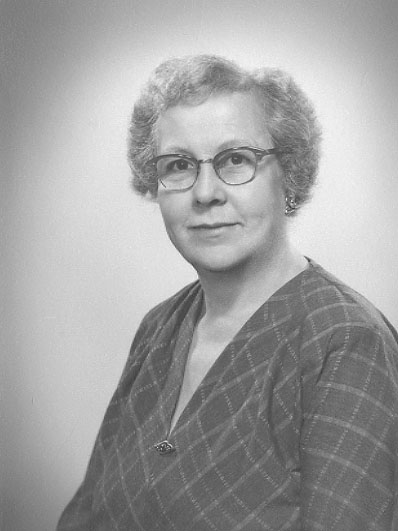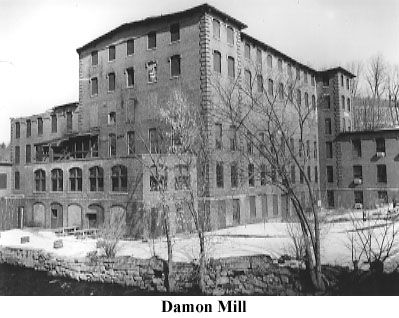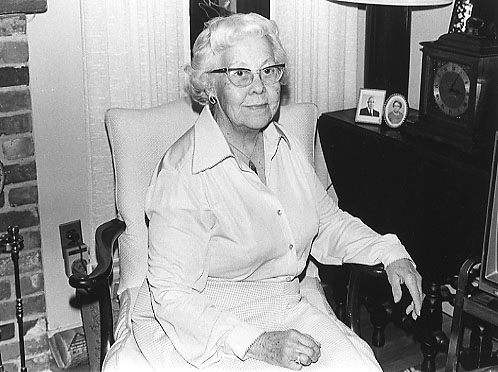Mrs. Winslow Damon (Florence M.)
179 Prairie Street
Interviewed November 4, 1977
Age 84
Concord Oral History Program
Renee Garrelick, Interviewer.
Click here for audio in .mp3 format
 Having read about them I know something of the divisions of
the West Concord area before it became Concord Junction. In the
middle of the 19th century the large cotton mill at the west end
of town was purchased by Calvin Damon, my husband's great-
grandfather. He later added looms for wool and successfully
manufactured a popular woolen-cotton flannel that was called domet
flannel. At that time the area around the mill was known as
Factory Village. The mill owned many acres of land and the houses
in which the workers lived were built by the mill on the streets
now known as Damon Street, Conant Street, and part of Main Street.
Having read about them I know something of the divisions of
the West Concord area before it became Concord Junction. In the
middle of the 19th century the large cotton mill at the west end
of town was purchased by Calvin Damon, my husband's great-
grandfather. He later added looms for wool and successfully
manufactured a popular woolen-cotton flannel that was called domet
flannel. At that time the area around the mill was known as
Factory Village. The mill owned many acres of land and the houses
in which the workers lived were built by the mill on the streets
now known as Damon Street, Conant Street, and part of Main Street.
In 1859, Henry David Thoreau surveyed the property including
the surrounding buildings and labeled his map "A Survey of Damon's
Mills". On the wall of the branch bank of the Middlesex Savings
in West Concord you can see a duplicate of the same survey map. I
have a photograph of that map because the original is owned by a
cousin.
If you look on the side of the brick mill it has a stone
inscription "Damondale". Mr. Damon and his son, Edward, developed
a library which they kept in the mill for the use of the workers,
and they accumulated quite a collection. I have a list somewhere
of those books in that library.
They also used what they called "the counting room" for
church services and for Sunday school. They had the ministers in
Concord take turns in coming up on Sunday afternoons to conduct a
service for the people in this end of town.
This area of town later became known as Westvale and had it's
own post office in the double house that still stands on Main
Street across from the mill. My husband's father was postmaster
there. In that double building also was Adams and Bridges Grocery
Store which was well known. Later they moved to the center of
West Concord where Joe Hay's shoe store and the Gail Mark Store
now are. Adams and Bridges was a very popular store in town. It
was one of the real old-fashioned country stores.
The population of Westvale was mostly English as they came
over from the woolen factories in England. The Damon Mill and the
farm property, which they had quite a lot of, reached almost to
where the Derby farm came west from the Assabet River. The very
old rambling Derby homestead was torn down only a few years ago to
make way for the present shopping center right along the railroad
tracks and the river. There was also a more modern house that was
the home of Benjamin Derby and his family. He was the postmaster
of the Concord Junction post office for many years. His widow is
still living and is almost 100 years old.
Beyond the Derby farm was the Sheehan property, a big farm,
which now has been converted into Concord Greene apartments.
Another section of town was Warnerville, which was across the
railroad tracks in the present center of West Concord. Mr. Warner
owned most of that property. He had a pail factory by Warner's
pond, named for him, and Nashoba Brook. The brook had a dam which
formed Warner's Pond. We all still call the bridge there on
Commonwealth Avenue the pail factory bridge. There was also a Warner's Hall above Joe Hay's shoe store. Our women's club met
there when I was president during World War II.
The Association Hall was across the street in the Association
Building. The top two floors have since been removed, and it is
now the present post office. The hall was upstairs on the second
floor and on the third floor was where the Odd Fellows met.
From Warnerville, coming along Commonwealth Avenue we come to
the reformatory section. This section had what we called the
white row and the green row. The white row was the row of
Victorian duplex houses on Commonwealth Avenue just before Elm
Street. These were houses that the reformatory workers could rent
for $12 a month. The heat was furnished by steam pipes from the
reformatory itself. The green row was called Elm Place and was on
the north side of the reformatory on Elm Street. There was no
reformatory circle then, it was just Elm Street, and it branched
off to form what is now Route 2A, what we called Great Road, which
led to Acton and North Acton. The other road was called Union
Turnpike, which is presently Route 2, and went to West Acton and
Harvard.
In the early days, the reformatory was exactly as it was
named. It was a place where younger transgressors were sent with
the idea that they could be reformed. They did everything in
their power to reform them; they had a school, a superintendent of
the school, a woodworking section, and they really did a great
deal for them. The reformatory officers at that time were really
some of the most respected people in town, very different from the
attitude now to the people who work in the state prisons. Some of
the big homes on Main Street and Commonwealth Avenue belonged to
the reformatory officers. They were important citizens in the
town.
Three of the officers wives founded the West Concord Women's
Club in 1902. They wanted to promote educational, social, and
philanthropic issues. They met on the third floor of the old
Association Hall. It is now our 75th anniversary of the club and
in our local West Concord newspaper it said, "We had a purposeful
past to emulate and preserve."
I used to teach in the old West Concord School which has
since been torn down. At the time I came, it was very overcrowded
and I held class in the assembly hall, and for part of the year we
had screens separating my third grade class from the kindergarten
class, which wasn't conducive to quiet learning. And the
following year I was in the basement looking around lally columns
at my charges.
But then, the Harvey Wheeler School was built in 1918 and was
made extensively for little children, but then the teachers of the
older grades saw the beautiful auditorium and were very envious.
So the 7th and 8th grades were moved over to the new building as
well as the 1st and 2nd grades. The rest of us stayed in the old
building but used the facilities of the Harvey Wheeler School. I
was at the West Concord School from September, 1916 to June, 1922
and then I got married. At that time, as soon as you got married,
you left teaching. But I later went back to substituting.
The Harvey Wheeler School was considered a very unique
facility, and we had people come from all over to view it. It was
mainly because it was one of the first one-story buildings, where
most schools had two or three floors. It had a single door
leading outdoors from each classroom so it made the evacuation of
children very convenient. It was made of an attractive yellow
brick. It was very innovative.
 I had three terms on the school committee and the last five
of those nine years, I was chairman of the committee. I served
from 1942 to 1951. During that time we started the core nucleus
of the Thoreau School and the Alcott School. There had been no
new school since the high school was built in 1929 on Stow Street.
We planned the heating facilities and the core of the school to
accommodate future needs but we built only the number of
classrooms that we needed at that time. Later we added an
auditorium, a cafeteria, and a gymnasium and another wing of
classrooms.
I had three terms on the school committee and the last five
of those nine years, I was chairman of the committee. I served
from 1942 to 1951. During that time we started the core nucleus
of the Thoreau School and the Alcott School. There had been no
new school since the high school was built in 1929 on Stow Street.
We planned the heating facilities and the core of the school to
accommodate future needs but we built only the number of
classrooms that we needed at that time. Later we added an
auditorium, a cafeteria, and a gymnasium and another wing of
classrooms.
My husband's brother had access to the Hayward Mill Pond and
had an ice house built by the dam on Hayward Mill Road. I can
remember them cutting the ice with big saws into great blocks and
making a channel to float the blocks down to the ice house. Then
he would put them in layers with sawdust between the layers to
keep them from melting. And I just happen to think that one of
the reasons that he could do that was that his business was
forestry. He had a moveable sawmill that he took around to
different woodlots. He took this ice by horse and team carrying
the blocks of ice to people's houses. People would put their little card in the window to show they wanted ice, and if it was
up one way it was a 10 cent piece and if it was turned upside down it
was a 25 cent piece. The men that delivered the ice met all kinds of
people and were quite social.
Strawberries and asparagus were outstanding crops of the
farmers in West Concord. There were big farms here that
specialized in those crops. We have sandy soil which is conducive
to growing those plants. It was a thriving business but the Cape
being a warmer climate could produce them earlier and
transportation had improved so that they could send them to market
in Boston before Concord's was ready to send. That cut into the
profit of the early produce from the farmers. Then as houses were
developed that took away some of the land cutting into that
thriving business.
Another business in West Concord was the Allen Chair Factory
in the center of town. It manufactured mostly office furniture,
desks and chairs. Mr. Allen owned that and he was a very fine
man. Then there was the harness factory that we called the
harness shop. The big main building was right flush on Main
Street, a great brown three-story building that belonged to the
Harvey Wheelers Sr. They also built all the houses on Crest
Street and Cottage Street for their workers, and that was always
referred to as harness shop hill.
Another business across the street from the pail factory was
Chapman's livery stable and blacksmith shop. That was where E & S
Service Station is now along the Nashoba Brook. The blueine factory was between the post office and the railroad tracks and
the building is still there. It was a very thriving mail order
business. They discovered they could put blueine for whitening
clothes on sheets of paper and by giving premiums or prizes for
selling the most blueine, they had children all over the country
selling their product. That caused the Concord Junction post
office to be a first-class post office because of the volume of
mail coming for the blueine factory.
When the Harvey Wheeler School, which wasn't called that at
that time, was being built the Harvey Wheelers offered to build a
clock tower as an addition to the school building and so with that
it became the Harvey Wheeler School. The bell in that tower, I
have been told, was at one time the bell in the Damon Mill used to
call the workers to work. For some reason it became lost for a
long time and was finally discovered again and was put in the
Harvey Wheeler clock tower. When the Armistice news came to us at
the end of World War I, there was great excitement, and the girl
that was the physical education teacher and I climbed the tower at
Harvey Wheeler School and rang that bell. We were scolded
afterwards, but it was great fun.
Of course we used to watch the troop trains come through
here. All these villages became Concord Junction because we had a
junction of the New York-New Haven Railroad going north and south
crossing the Boston & Maine trains going east and west. The New
Haven trains went from Lowell to Framingham to Fall River and
connected with the Fall River boat to New York. That was a popular way to travel. The Boston & Maine went from Boston to
Troy, New York, Mechanicsville and eventually to Montreal. There
was wonderful service on those trains.
Rideout Playground, which is now used by the recreation
department in the summer, was named for Percy Rideout, who was
killed in World War I. He was a twin brother of Gertrude Rideout,
who was a popular teacher of English at the high school and
directed plays which the young people put on. She is now retired.
Another person who was interesting was old Dr. Pickard. He
was the country doctor who serviced this end of town. He went
around first in his horse and buggy and then with his Model T
Ford. He wore celluloid collars and tweed tie four-in-hands. He
was a fine old fellow. His sister, Elmira Pickard, married my
husband's oldest brother. Dr. Pickard also had a big farm over
near where Sanborn School is now. He divided his time between
doctoring and farming. There is a road named for him over there
now.
The flu epidemic of 1918 was so bad that the schools in
Concord were closed for four weeks. During that time I went back
to Dedham, which was my home, and worked in a canteen there, and I
can remember cooking because so many families had no one to cook
for them. Their whole family'would be sick at the same time.
Particularly susceptible to that disease were pregnant women.
There were a great many fatalities with pregnant women. It was a very horrendous time!
